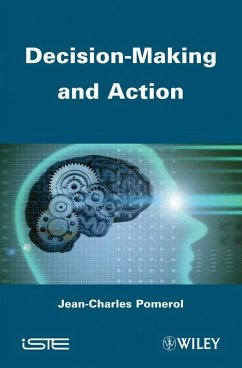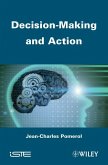Jean-Charles Pomerol
Decision Making and Action (eBook, ePUB)
139,99 €
139,99 €
inkl. MwSt.
Sofort per Download lieferbar

0 °P sammeln
139,99 €
Als Download kaufen

139,99 €
inkl. MwSt.
Sofort per Download lieferbar

0 °P sammeln
Jetzt verschenken
Alle Infos zum eBook verschenken
139,99 €
inkl. MwSt.
Sofort per Download lieferbar
Alle Infos zum eBook verschenken

0 °P sammeln
Jean-Charles Pomerol
Decision Making and Action (eBook, ePUB)
- Format: ePub
- Merkliste
- Auf die Merkliste
- Bewerten Bewerten
- Teilen
- Produkt teilen
- Produkterinnerung
- Produkterinnerung

Bitte loggen Sie sich zunächst in Ihr Kundenkonto ein oder registrieren Sie sich bei
bücher.de, um das eBook-Abo tolino select nutzen zu können.
Hier können Sie sich einloggen
Hier können Sie sich einloggen
Sie sind bereits eingeloggt. Klicken Sie auf 2. tolino select Abo, um fortzufahren.

Bitte loggen Sie sich zunächst in Ihr Kundenkonto ein oder registrieren Sie sich bei bücher.de, um das eBook-Abo tolino select nutzen zu können.
Making a decision, of any importance, is never simple. On the one hand, specialists in decision theory do not come within the reach of most policy makers and, secondly, there are very few books on pragmatic decision that are not purely anecdotal. In addition, there is virtually no book that provides a link between decision-making and action. This book provides a bridge between the latest results in artificial intelligence, neurobiology, psychology and decision-making for action. What is the role of intuition or emotion? What are the main psychological biases of which we must be wary? How can…mehr
- Geräte: eReader
- mit Kopierschutz
- eBook Hilfe
- Größe: 1.04MB
Andere Kunden interessierten sich auch für
![Discrete-Event Simulation and System Dynamics for Management Decision Making (eBook, ePUB) Discrete-Event Simulation and System Dynamics for Management Decision Making (eBook, ePUB)]() Discrete-Event Simulation and System Dynamics for Management Decision Making (eBook, ePUB)80,99 €
Discrete-Event Simulation and System Dynamics for Management Decision Making (eBook, ePUB)80,99 €![Decision Making and Action (eBook, PDF) Decision Making and Action (eBook, PDF)]() Jean-Charles PomerolDecision Making and Action (eBook, PDF)139,99 €
Jean-Charles PomerolDecision Making and Action (eBook, PDF)139,99 €![Virtual Natives (eBook, ePUB) Virtual Natives (eBook, ePUB)]() Catherine D. HenryVirtual Natives (eBook, ePUB)18,99 €
Catherine D. HenryVirtual Natives (eBook, ePUB)18,99 €![Practical Batch Process Management (eBook, ePUB) Practical Batch Process Management (eBook, ePUB)]() Barker B. Sc (Elec. Eng) MikePractical Batch Process Management (eBook, ePUB)41,95 €
Barker B. Sc (Elec. Eng) MikePractical Batch Process Management (eBook, ePUB)41,95 €![Nanotechnology (eBook, ePUB) Nanotechnology (eBook, ePUB)]() Nanotechnology (eBook, ePUB)90,95 €
Nanotechnology (eBook, ePUB)90,95 €![Risk Science (eBook, ePUB) Risk Science (eBook, ePUB)]() Terje AvenRisk Science (eBook, ePUB)48,95 €
Terje AvenRisk Science (eBook, ePUB)48,95 €![Healthy and Productive Work (eBook, ePUB) Healthy and Productive Work (eBook, ePUB)]() Healthy and Productive Work (eBook, ePUB)51,95 €
Healthy and Productive Work (eBook, ePUB)51,95 €-
-
-
Making a decision, of any importance, is never simple. On the one hand, specialists in decision theory do not come within the reach of most policy makers and, secondly, there are very few books on pragmatic decision that are not purely anecdotal. In addition, there is virtually no book that provides a link between decision-making and action. This book provides a bridge between the latest results in artificial intelligence, neurobiology, psychology and decision-making for action. What is the role of intuition or emotion? What are the main psychological biases of which we must be wary? How can we avoid being manipulated? What is the proper use of planning? How can we remain rational even if one is not an expert in probabilities? Perhaps more importantly for managers, how does one go from decision to action? So many questions fundamental to the practice of decision-making are addressed. This book dissects all issues that arise almost daily for decision-makers, at least for major decisions. Drawing on numerous examples, this book answers, in plain language and imagery, all your questions. The final chapter takes the form of a brief reminder - everything you have to remember to be a good decision-maker.
Dieser Download kann aus rechtlichen Gründen nur mit Rechnungsadresse in D ausgeliefert werden.
Produktdetails
- Produktdetails
- Verlag: John Wiley & Sons
- Erscheinungstermin: 27. Dezember 2012
- Englisch
- ISBN-13: 9781118588062
- Artikelnr.: 39054337
- Verlag: John Wiley & Sons
- Erscheinungstermin: 27. Dezember 2012
- Englisch
- ISBN-13: 9781118588062
- Artikelnr.: 39054337
- Herstellerkennzeichnung Die Herstellerinformationen sind derzeit nicht verfügbar.
Jean-Charles Pomerol is a specialist of Decision Support Systems, and former project leader for information technology in the Engineering Sciences Department at the CNRS. He was formerly in charge of the Artificial Intelligence laboratory at UPMC, Paris, France, as well as being the President of UPMC between 2006 and 2011. In this book, the author shares all this accumulated experience with the reader.
Introduction xi
Chapter 1 What is a Decision, or What Does Decision Theory Have to Teach
Us? 1
1.1 Actions and events 1
1.2 Probabilities 5
1.3 Expected utility 7
1.4 Subjective probabilities and rationality of the decision 12
1.5 Caveats and recommendations 14
Chapter 2 Scenarios and Conditional Probabilities 17
2.1 Scenarios 17
2.2 Compound probabilities 21
2.3 Scenarios and conditional probabilities 24
2.4 Decision tree 28
2.5 Scenarios, information and pragmatics 32
2.6 Pursuance of the scenarios and the "just one more push" 35
2.7 Conditional probabilities and accidents 39
2.8 Caveats and recommendations 41
Chapter 3 The Process of Decision-Making and its Rationality, or What Does
Artificial Intelligence Have to Teach Us? 43
3.1 A decision as a problem 43
3.2 Decision table 45
3.3 The general process of decision-making 46
3.4 Case-based reasoning 48
3.5 The Olympian point-of-view, and H Simon's view 51
3.6 Information 54
3.7 Limited rationality 57
3.8 Heuristics 60
3.9 Cognitive limitation 61
3.10 Feedback on rationality in decisions 62
3.11 Caveats and recommendations 64
Chapter 4 Intuition, Emotion, Recognition and Reasoning or, What Does the
Neurobiology of Decision-Making Have to Teach Us? 67
4.1 Introduction 68
4.2 Animal "decision" 69
4.3 Recognition-primed decision 70
4.4 The brain and emotion 73
4.5 Short-term, long-term 78
4.6 The Bayesian brain 83
4.7 Caveats and recommendations 85
Chapter 5 Decision-Making in the Presence of Conflicting Criteria, or What
Does a Multicriterion Decision Aid Have to Teach Us? 87
5.1 Preference structures 88
5.2 Multicriterion decision aid 91
5.3 Weighted sum aggregation 93
5.4 Other aggregation methods 100
5.5 Aggregation of votes 103
5.6 Social choice and collective decision 105
5.7 Individual reactions to multicriterion decision-making 109
5.8 Constraints and multicriterion decision-making in organizations 110
5.9 Caveats and recommendations 112
Chapter 6 The Decision-Maker's Psychology, or What Does Psychology Have to
Teach Us? 115
6.1 Introduction 116
6.2 The decision-maker's rationality and utility function 117
6.3 Constructing the utility function 119
6.4 Utility function in the risk 120
6.5 Loss aversion and the endowment effect 125
6.6 Biases related to the probabilities 126
6.7 Self-confidence and the illusion of control 134
6.8 Biases linked to memory 136
6.9 Frame effect 140
6.10 Level of reference and anchoring 144
6.11 Rationalization and reinforcement 154
6.12 System 1 or System 2? 156
6.13 Biases or heuristics? 159
6.14 Caveats and recommendations 162
Chapter 7 Context of the Decision: Intention, Commitment, Trust, Fairness,
Authority and Freedom 167
7.1 Intention and commitment 168
7.2 Trust and reciprocity 171
7.3 Fairness 177
7.4 Freedom and responsibility 180
7.5 Authority 182
7.6 "Leadership" in organizations 186
7.7 Rationality between logic and probabilities 189
7.8 Rationality and "good reasons" 192
7.9 Caveats and recommendations 197
Chapter 8 Action: Giving the Impetus or Managing 201
8.1 Deciding and acting 202
8.2 Quick or slow decision-makers 203
8.3 Consensual or imperative decision-makers 208
8.4 To act or to manage? That is the question 212
8.5 Reflect long, project long term: strategic planning and decision-making
in organizations 217
8.6 Feedback and learning 221
8.7 Conclusion 226
8.8 Caveats and recommendations 226
Chapter 9 Vade Mecum of the Acting Decision-Maker 229
9.1 That which depends on you, and that which does not 229
9.2 That which depends on you: information, imagination and the process of
decision-making 230
9.3 That which depends only on you: learning and planning 232
9.4 That which depends on nature: the pitfalls of probabilities 234
9.5 That which depends on our human nature: the pitfalls of the human brain
236
9.6 That which depends on other people: conflicts and manipulation 239
9.7 What the result depends on: your style and your action 241
9.8 And finally... 243
Bibliography 245
Index of Names 263
General Index 269
Chapter 1 What is a Decision, or What Does Decision Theory Have to Teach
Us? 1
1.1 Actions and events 1
1.2 Probabilities 5
1.3 Expected utility 7
1.4 Subjective probabilities and rationality of the decision 12
1.5 Caveats and recommendations 14
Chapter 2 Scenarios and Conditional Probabilities 17
2.1 Scenarios 17
2.2 Compound probabilities 21
2.3 Scenarios and conditional probabilities 24
2.4 Decision tree 28
2.5 Scenarios, information and pragmatics 32
2.6 Pursuance of the scenarios and the "just one more push" 35
2.7 Conditional probabilities and accidents 39
2.8 Caveats and recommendations 41
Chapter 3 The Process of Decision-Making and its Rationality, or What Does
Artificial Intelligence Have to Teach Us? 43
3.1 A decision as a problem 43
3.2 Decision table 45
3.3 The general process of decision-making 46
3.4 Case-based reasoning 48
3.5 The Olympian point-of-view, and H Simon's view 51
3.6 Information 54
3.7 Limited rationality 57
3.8 Heuristics 60
3.9 Cognitive limitation 61
3.10 Feedback on rationality in decisions 62
3.11 Caveats and recommendations 64
Chapter 4 Intuition, Emotion, Recognition and Reasoning or, What Does the
Neurobiology of Decision-Making Have to Teach Us? 67
4.1 Introduction 68
4.2 Animal "decision" 69
4.3 Recognition-primed decision 70
4.4 The brain and emotion 73
4.5 Short-term, long-term 78
4.6 The Bayesian brain 83
4.7 Caveats and recommendations 85
Chapter 5 Decision-Making in the Presence of Conflicting Criteria, or What
Does a Multicriterion Decision Aid Have to Teach Us? 87
5.1 Preference structures 88
5.2 Multicriterion decision aid 91
5.3 Weighted sum aggregation 93
5.4 Other aggregation methods 100
5.5 Aggregation of votes 103
5.6 Social choice and collective decision 105
5.7 Individual reactions to multicriterion decision-making 109
5.8 Constraints and multicriterion decision-making in organizations 110
5.9 Caveats and recommendations 112
Chapter 6 The Decision-Maker's Psychology, or What Does Psychology Have to
Teach Us? 115
6.1 Introduction 116
6.2 The decision-maker's rationality and utility function 117
6.3 Constructing the utility function 119
6.4 Utility function in the risk 120
6.5 Loss aversion and the endowment effect 125
6.6 Biases related to the probabilities 126
6.7 Self-confidence and the illusion of control 134
6.8 Biases linked to memory 136
6.9 Frame effect 140
6.10 Level of reference and anchoring 144
6.11 Rationalization and reinforcement 154
6.12 System 1 or System 2? 156
6.13 Biases or heuristics? 159
6.14 Caveats and recommendations 162
Chapter 7 Context of the Decision: Intention, Commitment, Trust, Fairness,
Authority and Freedom 167
7.1 Intention and commitment 168
7.2 Trust and reciprocity 171
7.3 Fairness 177
7.4 Freedom and responsibility 180
7.5 Authority 182
7.6 "Leadership" in organizations 186
7.7 Rationality between logic and probabilities 189
7.8 Rationality and "good reasons" 192
7.9 Caveats and recommendations 197
Chapter 8 Action: Giving the Impetus or Managing 201
8.1 Deciding and acting 202
8.2 Quick or slow decision-makers 203
8.3 Consensual or imperative decision-makers 208
8.4 To act or to manage? That is the question 212
8.5 Reflect long, project long term: strategic planning and decision-making
in organizations 217
8.6 Feedback and learning 221
8.7 Conclusion 226
8.8 Caveats and recommendations 226
Chapter 9 Vade Mecum of the Acting Decision-Maker 229
9.1 That which depends on you, and that which does not 229
9.2 That which depends on you: information, imagination and the process of
decision-making 230
9.3 That which depends only on you: learning and planning 232
9.4 That which depends on nature: the pitfalls of probabilities 234
9.5 That which depends on our human nature: the pitfalls of the human brain
236
9.6 That which depends on other people: conflicts and manipulation 239
9.7 What the result depends on: your style and your action 241
9.8 And finally... 243
Bibliography 245
Index of Names 263
General Index 269
Introduction xi
Chapter 1 What is a Decision, or What Does Decision Theory Have to Teach
Us? 1
1.1 Actions and events 1
1.2 Probabilities 5
1.3 Expected utility 7
1.4 Subjective probabilities and rationality of the decision 12
1.5 Caveats and recommendations 14
Chapter 2 Scenarios and Conditional Probabilities 17
2.1 Scenarios 17
2.2 Compound probabilities 21
2.3 Scenarios and conditional probabilities 24
2.4 Decision tree 28
2.5 Scenarios, information and pragmatics 32
2.6 Pursuance of the scenarios and the "just one more push" 35
2.7 Conditional probabilities and accidents 39
2.8 Caveats and recommendations 41
Chapter 3 The Process of Decision-Making and its Rationality, or What Does
Artificial Intelligence Have to Teach Us? 43
3.1 A decision as a problem 43
3.2 Decision table 45
3.3 The general process of decision-making 46
3.4 Case-based reasoning 48
3.5 The Olympian point-of-view, and H Simon's view 51
3.6 Information 54
3.7 Limited rationality 57
3.8 Heuristics 60
3.9 Cognitive limitation 61
3.10 Feedback on rationality in decisions 62
3.11 Caveats and recommendations 64
Chapter 4 Intuition, Emotion, Recognition and Reasoning or, What Does the
Neurobiology of Decision-Making Have to Teach Us? 67
4.1 Introduction 68
4.2 Animal "decision" 69
4.3 Recognition-primed decision 70
4.4 The brain and emotion 73
4.5 Short-term, long-term 78
4.6 The Bayesian brain 83
4.7 Caveats and recommendations 85
Chapter 5 Decision-Making in the Presence of Conflicting Criteria, or What
Does a Multicriterion Decision Aid Have to Teach Us? 87
5.1 Preference structures 88
5.2 Multicriterion decision aid 91
5.3 Weighted sum aggregation 93
5.4 Other aggregation methods 100
5.5 Aggregation of votes 103
5.6 Social choice and collective decision 105
5.7 Individual reactions to multicriterion decision-making 109
5.8 Constraints and multicriterion decision-making in organizations 110
5.9 Caveats and recommendations 112
Chapter 6 The Decision-Maker's Psychology, or What Does Psychology Have to
Teach Us? 115
6.1 Introduction 116
6.2 The decision-maker's rationality and utility function 117
6.3 Constructing the utility function 119
6.4 Utility function in the risk 120
6.5 Loss aversion and the endowment effect 125
6.6 Biases related to the probabilities 126
6.7 Self-confidence and the illusion of control 134
6.8 Biases linked to memory 136
6.9 Frame effect 140
6.10 Level of reference and anchoring 144
6.11 Rationalization and reinforcement 154
6.12 System 1 or System 2? 156
6.13 Biases or heuristics? 159
6.14 Caveats and recommendations 162
Chapter 7 Context of the Decision: Intention, Commitment, Trust, Fairness,
Authority and Freedom 167
7.1 Intention and commitment 168
7.2 Trust and reciprocity 171
7.3 Fairness 177
7.4 Freedom and responsibility 180
7.5 Authority 182
7.6 "Leadership" in organizations 186
7.7 Rationality between logic and probabilities 189
7.8 Rationality and "good reasons" 192
7.9 Caveats and recommendations 197
Chapter 8 Action: Giving the Impetus or Managing 201
8.1 Deciding and acting 202
8.2 Quick or slow decision-makers 203
8.3 Consensual or imperative decision-makers 208
8.4 To act or to manage? That is the question 212
8.5 Reflect long, project long term: strategic planning and decision-making
in organizations 217
8.6 Feedback and learning 221
8.7 Conclusion 226
8.8 Caveats and recommendations 226
Chapter 9 Vade Mecum of the Acting Decision-Maker 229
9.1 That which depends on you, and that which does not 229
9.2 That which depends on you: information, imagination and the process of
decision-making 230
9.3 That which depends only on you: learning and planning 232
9.4 That which depends on nature: the pitfalls of probabilities 234
9.5 That which depends on our human nature: the pitfalls of the human brain
236
9.6 That which depends on other people: conflicts and manipulation 239
9.7 What the result depends on: your style and your action 241
9.8 And finally... 243
Bibliography 245
Index of Names 263
General Index 269
Chapter 1 What is a Decision, or What Does Decision Theory Have to Teach
Us? 1
1.1 Actions and events 1
1.2 Probabilities 5
1.3 Expected utility 7
1.4 Subjective probabilities and rationality of the decision 12
1.5 Caveats and recommendations 14
Chapter 2 Scenarios and Conditional Probabilities 17
2.1 Scenarios 17
2.2 Compound probabilities 21
2.3 Scenarios and conditional probabilities 24
2.4 Decision tree 28
2.5 Scenarios, information and pragmatics 32
2.6 Pursuance of the scenarios and the "just one more push" 35
2.7 Conditional probabilities and accidents 39
2.8 Caveats and recommendations 41
Chapter 3 The Process of Decision-Making and its Rationality, or What Does
Artificial Intelligence Have to Teach Us? 43
3.1 A decision as a problem 43
3.2 Decision table 45
3.3 The general process of decision-making 46
3.4 Case-based reasoning 48
3.5 The Olympian point-of-view, and H Simon's view 51
3.6 Information 54
3.7 Limited rationality 57
3.8 Heuristics 60
3.9 Cognitive limitation 61
3.10 Feedback on rationality in decisions 62
3.11 Caveats and recommendations 64
Chapter 4 Intuition, Emotion, Recognition and Reasoning or, What Does the
Neurobiology of Decision-Making Have to Teach Us? 67
4.1 Introduction 68
4.2 Animal "decision" 69
4.3 Recognition-primed decision 70
4.4 The brain and emotion 73
4.5 Short-term, long-term 78
4.6 The Bayesian brain 83
4.7 Caveats and recommendations 85
Chapter 5 Decision-Making in the Presence of Conflicting Criteria, or What
Does a Multicriterion Decision Aid Have to Teach Us? 87
5.1 Preference structures 88
5.2 Multicriterion decision aid 91
5.3 Weighted sum aggregation 93
5.4 Other aggregation methods 100
5.5 Aggregation of votes 103
5.6 Social choice and collective decision 105
5.7 Individual reactions to multicriterion decision-making 109
5.8 Constraints and multicriterion decision-making in organizations 110
5.9 Caveats and recommendations 112
Chapter 6 The Decision-Maker's Psychology, or What Does Psychology Have to
Teach Us? 115
6.1 Introduction 116
6.2 The decision-maker's rationality and utility function 117
6.3 Constructing the utility function 119
6.4 Utility function in the risk 120
6.5 Loss aversion and the endowment effect 125
6.6 Biases related to the probabilities 126
6.7 Self-confidence and the illusion of control 134
6.8 Biases linked to memory 136
6.9 Frame effect 140
6.10 Level of reference and anchoring 144
6.11 Rationalization and reinforcement 154
6.12 System 1 or System 2? 156
6.13 Biases or heuristics? 159
6.14 Caveats and recommendations 162
Chapter 7 Context of the Decision: Intention, Commitment, Trust, Fairness,
Authority and Freedom 167
7.1 Intention and commitment 168
7.2 Trust and reciprocity 171
7.3 Fairness 177
7.4 Freedom and responsibility 180
7.5 Authority 182
7.6 "Leadership" in organizations 186
7.7 Rationality between logic and probabilities 189
7.8 Rationality and "good reasons" 192
7.9 Caveats and recommendations 197
Chapter 8 Action: Giving the Impetus or Managing 201
8.1 Deciding and acting 202
8.2 Quick or slow decision-makers 203
8.3 Consensual or imperative decision-makers 208
8.4 To act or to manage? That is the question 212
8.5 Reflect long, project long term: strategic planning and decision-making
in organizations 217
8.6 Feedback and learning 221
8.7 Conclusion 226
8.8 Caveats and recommendations 226
Chapter 9 Vade Mecum of the Acting Decision-Maker 229
9.1 That which depends on you, and that which does not 229
9.2 That which depends on you: information, imagination and the process of
decision-making 230
9.3 That which depends only on you: learning and planning 232
9.4 That which depends on nature: the pitfalls of probabilities 234
9.5 That which depends on our human nature: the pitfalls of the human brain
236
9.6 That which depends on other people: conflicts and manipulation 239
9.7 What the result depends on: your style and your action 241
9.8 And finally... 243
Bibliography 245
Index of Names 263
General Index 269







